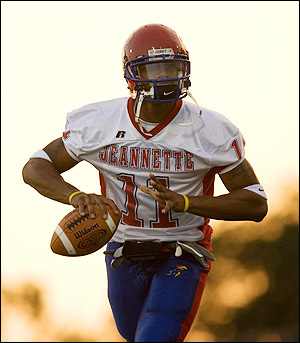Behind the rankings
No. 16 QB Terrelle Pryor of Jeannette (Pa.) High.
If you follow recruiting at all, you probably know that Rivals.com and Scout.com consider Pryor the No. 1 overall prospect. You probably also know that ESPN's Scouts Inc. ranks Pryor as the No. 4 player, though they hedged by calling Pryor an "athlete" rather than a quarterback. So why, you ask, did Offense-Defense Football -- who provides the rankings for SI and TAKKLE.com (Sports Illustrated is an investor in Takkle) -- rank Pryor so low? Bill Urbanik, a former college (Wake Forest) and NFL assistant (Bengals, Raiders) and NFL player-personnel official (Raiders) who is one of several ex-coaches who evaluates players for O-D, said there is rationale behind the ranking.
"O-D is not disputing [Pryor's] brilliance," said Urbanik, who now teaches school during the week and serves as the analyst on Wake Forest's radio team in the fall. "We're not disputing anything about him. What we're looking at is the player he'll be four years from now."
In fact, O-D's scouts think E.J. Manuel, a Florida State commitment from Virginia Beach, Va., is the nation's top quarterback prospect and the No. 8 overall prospect. O-D recruiting director Dan Licursi said the composite opinion of his scouts was that though Pryor (6-foot-6, 220 pounds) has a slight edge in athleticism over Manuel (6-4, 201), Manuel has a better arm and seems more willing to stay in the pocket and throw instead of scrambling.
"One of the things that stuck out to us with E.J.," Licursi said, "is even though he's listed as a dual-threat, he shows a lot more poise in the pocket and good arm strength."
Urbanik said Pryor is the most difficult type of player to project -- an athletic, big-armed quarterback. That may sound like a slam dunk, but history has shown those players don't find success in college with the same consistency as, say, a 6-4 receiver with blazing speed. "Remember a guy named Xavier Lee?" Urbanik asked.
In 2004, Rivals ranked Lee the second-best quarterback and the No. 10 overall prospect. Scout ranked him the No. 2 quarterback and No. 11 overall. He had a huge arm, huge statistics, and unlike Pryor, who plays at a tiny high school in Western Pennsylvania, Lee played at a medium-to-large school in Daytona Beach, Fla., against better competition. But in four years at Florida State, Lee never could beat out Drew Weatherford, whom Rivals ranked the No. 88 overall prospect that year. Lee recently left the Seminoles to enter the draft because he didn't want to move to tight end.
Of course, for every Xavier Lee, there is a Vince Young or a Tim Tebow. Both were athletic, big-armed high school quarterbacks who were highly ranked by Rivals and Scout. Young finished second in the 2005 Heisman Trophy voting and led Texas to the national title that year. Florida's Tebow became the first sophomore to win the Heisman last season.
That disparity is precisely Urbanink's point. Unlike other positions, the dual-threat quarterback has more of a boom-bust quality when players move up a level. This season, former college and pro players and coaches working for O-D evaluated video of 4,000 players. The evaluators sent in their findings, which were then culled into a composite ranking. Based on their opinions, Pryor wound up at No. 16. That isn't so bad, Urbanik pointed out. If Pryor finishes his career as 16th-best player in college football, he could be a first-round NFL draft pick. Still, Pryor will have the next few years to prove O-D wrong.
"If Pryor goes and is one of the finalists for the Heisman Trophy in four or five years, then obviously Offense-Defense was wrong," Urbanik said. "But if he's not one of the finalists for the Heisman Trophy three, four or five years from now then Offense-Defense was correct."





